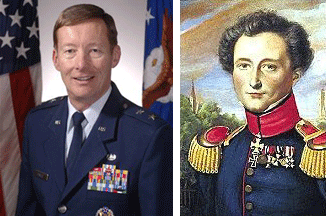
Maj. Gen. Charles J. Dunlap Jr., left; General Carl von Clausewitz, right
The surge to victory for John McCain in yesterday’s New Hampshire primary is attributed by Senator McCain to his telling the truth on a statewide bus tour. Truth and politics are seldom embedded fellows, so surely there is more at stake. It may be that the seeming success of the “surge” of U.S. troops combined with McCain’s last ditch, Chuck Norris tactic of shouting that he will get Osama on Day One in the White House was a factor in rousing New England independents to brave the snowbanks. Less American soldiers are reported dead in the daily papers, the suicide bombings in Baghdad are claiming less lives, and the economy looms larger in voter minds in the current trillion-dollar-deficit-spent free fall. The Democrats, on the other partisan hand, dismiss the Bush/McCain surge as the kind of military victory that can not win the diplomatic war in the end. Most of us would like to find some kind of truth in all the spin, but the super-media-charged primary machine surges on with truth as the main casualty.
So what do the generals say we should do? Today’s New York Times carries an op-ed commentary by Charles J. Dunlap Jr., an Air Force major general, who is about to publish a monograph called Shortchanging the Joint Fight?. In the general’s gung-ho “We Still Need the Big Guns,” he writes tooth and Clausewitz that effective counter insurgency in Iraq and future conflicts still needs to be measured in dead insurgent bodies. As he states:
Many analysts understandably attribute the success to our troops’ following the dictums of the Army’s lauded new counterinsurgency manual. While the manual is a vast improvement over its predecessors, it would be a huge mistake to take it as proof — as some in the press, academia and independent policy organizations have — that victory over insurgents is achievable by anything other than traditional military force.
Unfortunately, starry-eyed enthusiasts have misread the manual to say that defeating an insurgency is all about winning hearts and minds with teams of anthropologists, propagandists and civil-affairs officers armed with democracy-in-a-box kits and volleyball nets. They dismiss as passé killing or capturing insurgents.
Actually, the reality is quite different. The lesson of Iraq is that old-fashioned force works. Add 30,000 of the world’s finest infantry to the 135,000 battle-hardened troops already there, as we have done, and the outnumbered insurgency is in serious trouble. Detain thousands more Iraqis as security threats, and the potential for violence inevitably declines. Press reports indicate that the number of Iraqis in prison doubled over the last year, to 30,000 from 15,000; and while casualty figures are sketchy, military officials told USA Today last September that the number of insurgents killed was already 25 percent higher in 2007 than in all of 2006.
In early 2008 the martial 1812 Overture meets Alic Cooper’s “No More Mr. Nice Guy.” I am not disagreeing with General Dunlop, whose pragmatic assessment suggests that the surge is not just about more bodies but more use of high-tech weapons. But the argument that better technology brings victory is not new. The Gatling Gun mowed down American Indians armed with bows and arrows. Truman dropped the H-bomb on Hiroshima with the avowed purpose of avoiding a bloody invasion of Japan. When you kill enough of the enemy you can’t help but win something.
But is it really the case that the only good insurgent is a dead insurgent? The counter insurgency manual that General Dunlop critiques as too soft is hardly about appeasement, letting the evildoers off the hook to go and fight us another day. Chivalry stopped with Saladin, to the extent it was ever a major part of warfare. The point is that some disputes are so culturally charged that killing the bad guys involves far too much killing of innocents and is doomed to ultimate failure short of genocide. The daily atrocities in Iraq, not unlike those taking place over the past week in Kenya, are not the stuff of armies engaged in combat. The Coalition forces in Iraq are, no matter how you spin it, occupying a country and will eventually leave.
The idea that victory is about killing insurgents is hopelessly flawed, as unattainable in reality as the notion that any people liberated from a dictator will welcome American style democracy as they have jeans and Coca Cola. It is not clear who is an insurgent, since much of the fighting is sectarian and due to local power struggles. Every so-called insurgent who is blown to bits in an air raid usually takes with him innocent individuals, women and children. So for every insurgent tallied more individuals are fired up through hatred and grief to retaliate. Democracy-in-a-box kits are, as General Dunlop rightly warns, stupid ideas, and volleyball is hardly a sport to encourage in a nation that breathes soccer. But this is all about cultural differences, not simply ideological firebombing. As an anthropologist I have my doubts about the benefit of embedding anthropologists in the field operations of the military, but unless Iraq is bombed back to Eden the high-tech solution can only be a temporary fix.
But those who live and send other to die by Clausewitz, might pause a moment to get at the truth of the matter. As the strategic master himself said:
For the aim of historians rarely is to present the absolute truth. Usually they wish to embellish the deeds of their army or to demonstrate the concordance of events with their imaginary rules. They invent history instead of writing it.
In this sense I think it safe to say we are all historians and the truth is as inventable today as it ever was.
Daniel Martin Varisco